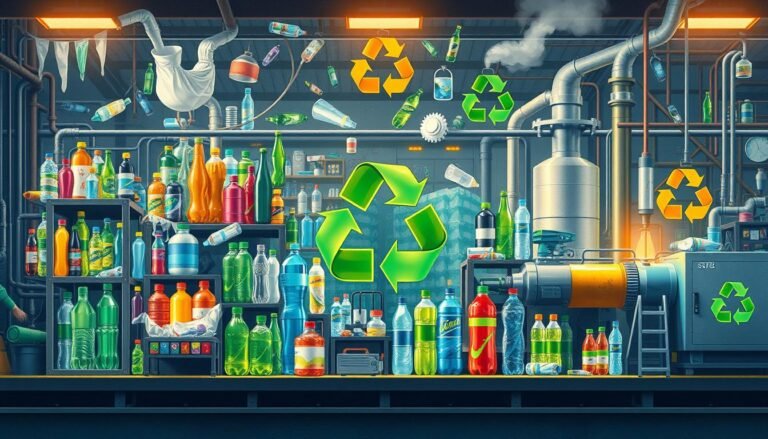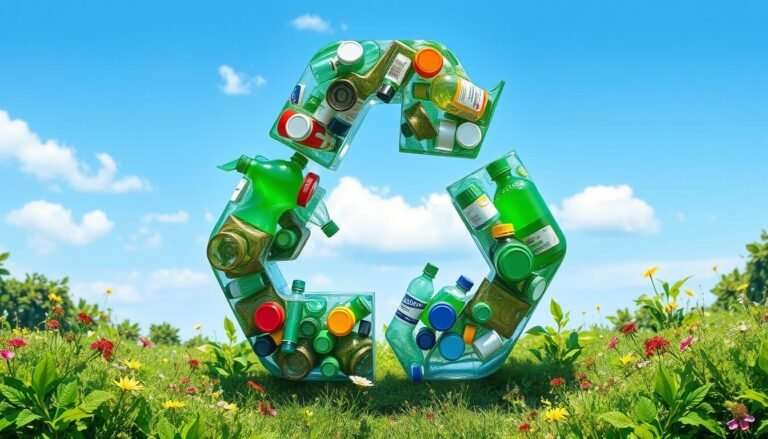Make some changes to the world environment
-
Building 3, Wanyang Innovation City, Langxia Street, Yuyao City, Zhejiang Province
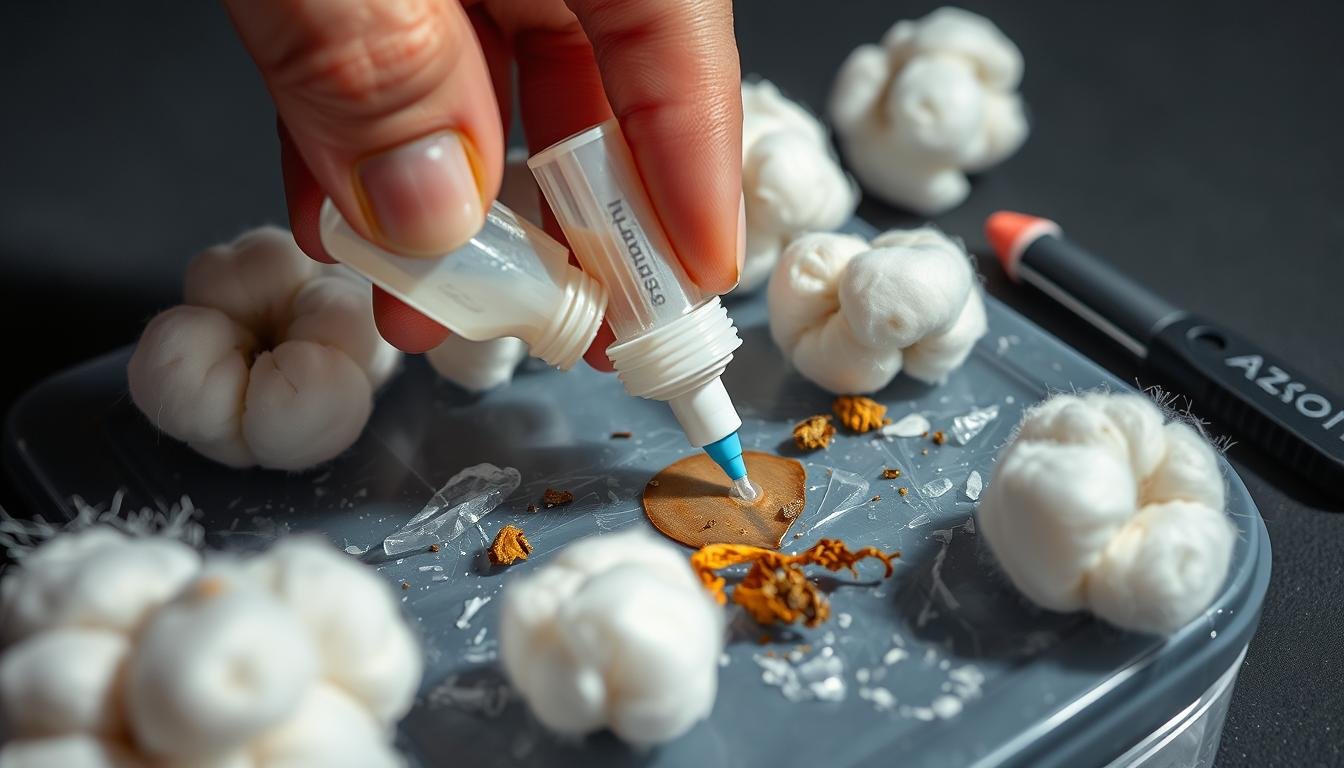
Remove Super Glue From Plastic: Quick Guide
Ever wonder why super glue is tough to remove from plastic? This adhesive can hold more than a ton on just a tiny area. Yet, getting it off plastic can be really hard1. But don’t worry, removing it can be easy. In this guide, we show you how to take super glue off plastic without harm.
Key Takeaways
- Super glue quickly makes a strong bond, making it hard to get off plastic surfaces1.
- Acetone can dissolve super glue but be careful when using it23.
- You can also try white vinegar, rubbing alcohol, petroleum jelly, or WD-4031.
- It’s important to prep the area and protect other surfaces to avoid more damage.
- After getting the glue off, clean and fix the area to keep the plastic good as new.
Understanding Super Glue and Its Effects on Plastic
Super glue is also known as cyanoacrylate adhesive. It’s famous for its strong and fast bonding. The main types are methyl 2-cyanoacrylate and ethyl-2-cyanoacrylate4. These make tough polymer bonds, perfect for speedy fixes5.
Super glue bonds quickly. It takes 5 to 90 seconds for an initial hold and 8 to 24 hours for full strength, depending on the glue and surfaces4. It’s excellent with plastics, creating tough, lasting bonds5. But be careful, it might discolor or damage plastic if not used right.
To remove super glue from plastic correctly, knowing the chemical reactions is key. Techniques include soaking in nitromethane or using ammonia-free detergent and water5. It’s important to know the plastic type to avoid harm while cleaning it off.
There are various cyanoacrylate formulas, each with its own uses and temperature limits. Most cyanoacrylates work up to 200°F, some even up to 275°F4. This knowledge is a big help in removing super glue.
To choose the best super glue removal methods, you need to understand how it works with plastic. Solvents like acetone are very effective2. White vinegar is a milder option that can dissolve the adhesive2. WD-40 Multi-Use Product is also good for getting rid of tough glue on plastic2.
Materials You Will Need for Super Glue Removal
Removing super glue from plastic needs the right materials for the best results. Depending on the plastic type, you’ll need specific tools and solvents.
Essential Tools for the Job
Here’s what you’ll need to remove super glue from plastic:
- Cotton Balls: Perfect for applying solvents with precision.
- Gloves: Keep your hands safe from harsh chemicals like acetone.
- Plastic Scraper: This tool gently removes glue without harming the plastic.
- Soft Cloth: Clean away any glue residue softly.
Choosing the Right Solvent
Picking the right solvent is a big part of getting glue off plastic. Acetone works well because it quickly dissolves super glue. But be careful, it can also take off the plastic’s color and finish6. If you’re working with sensitive plastics, you might want to use gentler options. White vinegar or lemon juice can be safer choices5.
| Solvent | Effectiveness | Use with Caution |
|---|---|---|
| Acetone | High | Can strip color/finish |
| White Vinegar | Moderate | Gentle on delicate plastics |
| Lemon Juice | Moderate | Effective on various materials |
| Vegetable Oil | Low | Safe and non-toxic |
| Krazy® Fix Super Glue Remover | High | Strong adhesive remover |
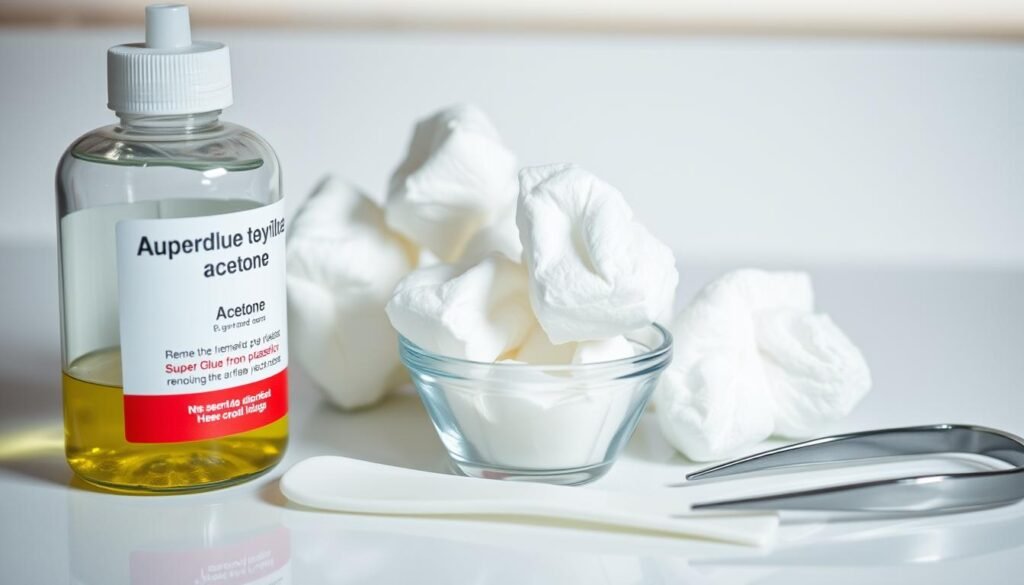
How Do I Remove Super Glue From Plastic
It’s tricky to get super glue off plastic, but a careful plan makes it easier.
Step-by-Step Process
First, get everything you need like acetone, cotton balls, gloves, and a soft cloth. Protect your area and wear gloves to keep your skin safe from acetone. Put a cotton ball soaked in acetone on the glue spot, letting the acetone break the glue down. Acetone works well for removing super glue from most surfaces, including plastic23.
Leave the acetone on the glue for a few minutes. When the glue gets soft, gently dab it off with a soft cloth. Go slow to avoid scratching the plastic. For more tips on getting super glue off various things, check this guide.
Measures to Avoid Damage
Acetone is strong and can damage or fade things21. If you’re worried, try white vinegar or rubbing alcohol instead. They can also dissolve super glue without harming the plastic21. Always test the solution on a small spot first to make sure it’s safe.
WD-40 is also a gentle option for sensitive surfaces. Spray it on the glue, wait, then wipe it off with a wet cloth. It’s good for plastic and won’t scratch23.
Following these tips and taking precautions makes removing super glue from plastic both easy and safe. For more help and step-by-step methods, see this detailed guide.
Using Acetone to Remove Super Glue
Acetone is great at breaking down the chemical parts of super glue. This makes it a top pick for getting glue off plastic. Super glue sticks very strongly to plastic. Without the right solvent, it’s hard to separate them. Acetone works well to break these tough bonds quickly5.
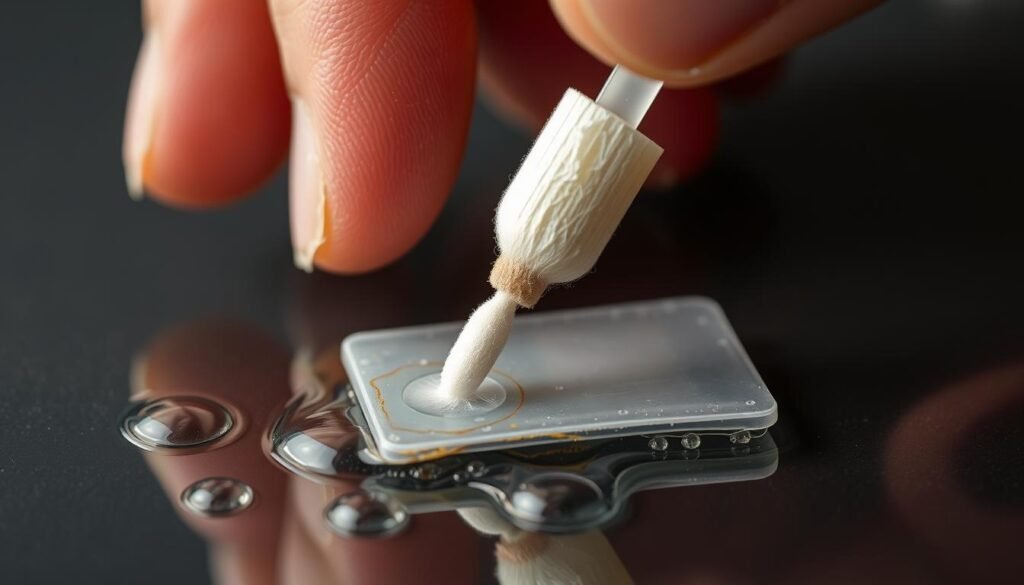
Why Acetone Works
Acetone can get deep into the super glue and take apart its pieces. This stops the glue from damaging the plastic2. Since acetone dries fast, it reduces the risk of harm. This makes it safer to use for removing glue from plastic.
Application Tips and Safety Precautions
Using acetone safely and effectively means following some key tips:
- Use gloves: Wearing gloves is important to keep your skin safe from irritation while using acetone2.
- Adequate ventilation: Make sure the area is airy to avoid breathing in bad fumes.
- Precise application: Apply acetone with cotton balls or rounds directly on the glue. Be careful not to spill it2.
- Quick action: Acetone works fast and evaporates quickly, so act fast to protect the plastic2.
Keeping these tips in mind helps remove glue from plastic safely and effectively.
Alternative Methods: Vinegar, Rubbing Alcohol, and WD-40
Exploring alternative methods like vinegar, rubbing alcohol, and WD-40 is beneficial. These items are gentler on surfaces but still effective.
Using Vinegar for a Gentler Approach
White distilled vinegar is great for cleaning glue off hard surfaces like metal, plastic, and glass7. It’s cheaper and more natural than other cleaners. To remove super glue from plastic, just soak a cloth in vinegar and lay it on the glue. It makes the glue easy to wipe off.
Rubbing Alcohol as a Solvent
Rubbing alcohol can also remove super glue from plastic without damage. Just apply it with a cloth and rub gently. This way is simple and works well.
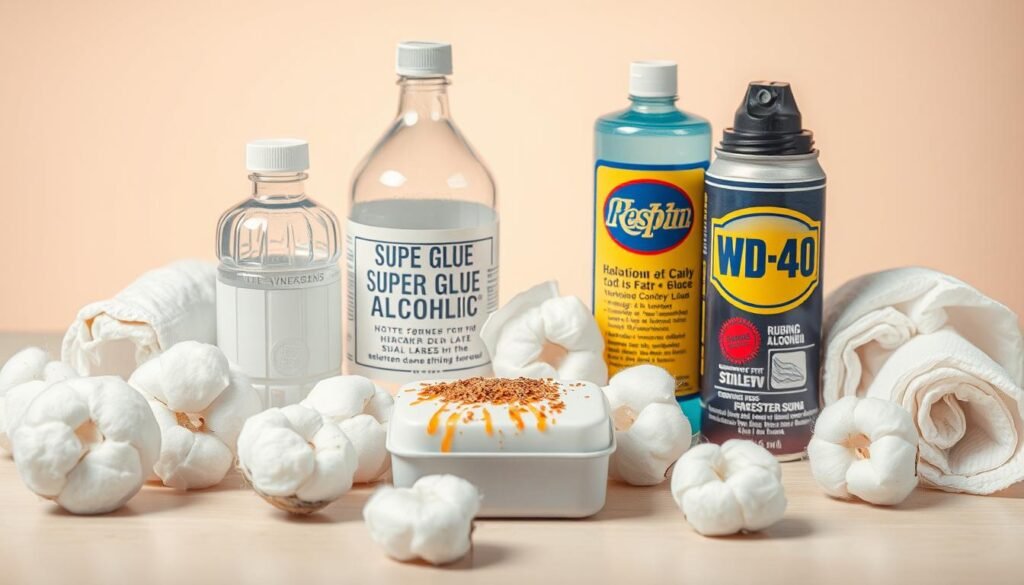
WD-40 for Stubborn Glue Residue
WD-40 is great for tough glue residue. It breaks down the glue’s adhesiveness, making it easy to remove. Spray it on, wait, then wipe the glue away8. WD-40 is a trusted method among many8.
Using these alternative methods can remove super glue from plastic safely. For more about recycling and sustainable living, check out the PVC recycling guide8.
Steps to Take Before Applying Any Solvent
Before using any solvent to take off super glue from plastic, make sure you’re ready. It’s crucial to prep the area correctly. This includes steps that make sure you apply the solvent well and stay safe.
Prepping the Area
Start by cleaning the spot that needs treatment. Removing dirt or debris ensures the solvent works better. A clean area lets the solvent, like acetone, effectively dissolve the glue2.
Use tools like a plastic spatula for careful removal of glue bits. This method doesn’t harm the plastic5.

Get all tools ready and easy to grab before starting. Make sure you’re in a space with good airflow. This is key to avoid breathing in harmful fumes, especially with strong solvents like acetone2.
Protecting Surrounding Surfaces
Use old cloths or newspapers to cover areas around the work spot. It helps keep solvent spills or drips in check. Thus, only the super glue bits get treated. Protective steps keep the solvent from damaging other surfaces, like tables or your nails2.
It’s smart to wear gloves to keep your skin safe from acetone or other harsh chemicals. Gloves cut down skin irritation risks. Plus, make sure your workspace is tidy and you have your tools, such as cotton swabs soaked in acetone, ready2.
For tips on making your plastic extrusion processes better, check out this detailed guide to single screw plastic.
How to Apply and Remove Acetone or Other Solvents
To remove super glue from plastic, use solvents like acetone, vinegar, or rubbing alcohol with care. We will look into ways to effectively take off super glue from plastic surfaces.
Detailed Application Method
For accurate acetone use, opt for a Q-tip or a small brush. This prevents the solvent from spreading where it shouldn’t on the plastic. Acetone is strong and works well since it can dissolve many things9. First, do a spot test on a hidden part of the plastic to avoid damage. If acetone is risky for the item, try using vinegar or non-acetone nail polish remover as a substitute10.
Removing Excess Residue
Once the glue is loose, take off any leftover residue fast. Wipe softly with a moist cloth or light soap. This step makes sure no acetone or glue bits are left, keeping the plastic safe. If glue sticks around, try again but gently to not harm the plastic. Removing glue from skin may need similar care, especially with tough spots9 and10.
Safety Tips When Using Solvents and Tools
Keeping safe is key when removing plastic glue with solvents and tools. It’s crucial to work in an area with good airflow. This stops you from breathing in harmful fumes. Make sure to wear gloves and goggles to protect your skin and eyes from spills.
Always read the instructions and safety warnings on solvent bottles carefully. Acetone, for example, can dissolve super glue fast but might also harm some plastics11. On the other hand, rubbing alcohol is softer and less risky for plastics11. Yet, it’s still smart to test it on a small spot first.
Using a hair dryer can help loosen super glue on big surfaces11. If you’re working with delicate plastics, warm soapy water is your best bet. It’s less likely to cause damage11. But remember, steer clear of cement glue for fixes. It melts plastics together, which you can’t undo12.
Proper handling and situational awareness are crucial in preventing accidents and ensuring a safe and effective plastic glue removal process.
Post-Removal Care for Plastic Surfaces
After you remove plastic adhesive, it’s crucial to clean and repair the plastic surface if needed.
Cleaning the Surface
Cleaning after removal keeps your plastic items looking good and working right. Use mild cleaners or soapy water to get rid of any glue or solvent left behind. This makes sure your plastic is clean and free from harmful chemicals. Things like liquid dish soap, vegetable oil, and diluted nail polish remover work well to get rid of any glue still sticking around13.
You can also use vinegar, nail polish remover, or rubbing alcohol on a cloth to wipe away any glue left. Make sure the glue is dry before you try to clean it. This helps avoid smears on your plastic items14.
Repairing Any Minor Damage
Removing super glue sometimes leaves small scratches or makes the surface less shiny. When this happens, you might need to fix these minor issues. Lightly sanding the area with fine-grit sandpaper can remove stubborn glue without more damage13. If removing the glue leaves marks, polishing the area can help.
There are special polishes and treatments for plastic that can make it look shiny and new again. For delicate or badly damaged areas, a plastic scraper and a cotton ball with rubbing alcohol and mineral spirits can help clean it up14.
In summary, caring for your plastic surfaces after removing adhesive improves their look and lifetime. The success is in both the removal and how well you care for the items afterward.
Conclusion
Removing super glue from plastic needs careful steps to avoid harm. You can use acetone, a strong solvent, to dissolve the glue. Other gentle options include vinegar or rubbing alcohol. It’s important to pick the best method for your situation15. Acetone is very effective and often suggested15.
Trying vinegar with lukewarm water or cooking oil can also work well, especially for small spots16. Before you start, prepare the area and protect nearby surfaces. If the glue won’t come off, you might need professional help15.
Following these steps and safety tips, you can make your plastic look new again. Also, being careful and using glue wisely can prevent future issues15. Learn more about recycling by checking out our full guide on recycling polypropylene plastic.


